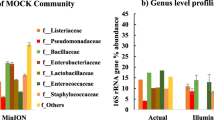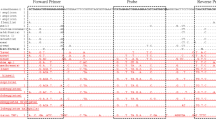Abstract
Ethidium monoazide bromide (EMA) and propidium monoazide (PMA), in combination with amplicon-based sequencing (ABS) and quantitative polymerase chain reaction (qPCR) assays, were compared for the detection of viable bacterial species in rainwater. The ABS α- and β-diversity indices indicated that, in comparison to the untreated samples, both EMA and PMA reduced the detection of non-viable bacteria in the rainwater samples. However, while comparable results were obtained for the detection of the most abundant bacterial families and genera in the rainwater samples for both the EMA and PMA pre-treatments; the EMA pre-treatment produced highly significant differences in the relative abundance of the dominant bacterial families and genera, and significantly decreased the detection of “unclassified” bacteria in comparison to the untreated samples (i.e. unclassified genera: untreated 46.7% versus EMA-treated 39.7%). Additionally, the inclusion of EMA and PMA allowed for the increased detection of less abundant pathogenic bacteria in the rainwater samples, such as Clostridium, Listeria and Streptococcus spp. The qPCR assays also indicated that the EMA and PMA pre-treatments were comparable for the detection of intact and potentially viable Acinetobacter, Legionella and Pseudomonas spp. The combination of viability pre-treatments with ABS thus offers a comprehensive monitoring approach to detect less abundant bacterial genera and/or pathogens, which may pose a health risk to the end-users (prioritise target organisms) of unpiped environmental water sources. Moreover, the subsequent combination of the viability pre-treatments with qPCR allows for the specific detection and quantification of these pathogenic genera, which increases analysis sensitivity and allows for the application of risk assessment and water safety strategies.





Similar content being viewed by others
Data Availability
The datasets generated during and/or analysed during the current study are available from the corresponding author on reasonable request.
References
Ahmed, W., Staley, C., Hamilton, K. A., Beale, D. J., Sadowsky, M. J., Toze, S., & Haas, C. N. (2017). Amplicon-based taxonomic characterization of bacteria in urban and peri-urban roof-harvested rainwater stored in tanks. Science of the Total Environment, 576, 326–334. https://doi.org/10.1016/j.scitotenv.2016.10.090.
Bibby, K., Viau, E., & Peccia, J. (2010). Pyrosequencing of the 16S rRNA gene to reveal bacterial pathogen diversity in biosolids. Water Research, 44, 4252–4260. https://doi.org/10.1016/j.watres.2010.05.039.
Bouvresse, S., Socolovshi, C., Berdjane, Z., Durand, R., Izri, A., Raoult, D., Chosidow, O., & Brouqui, P. (2011). No evidence of Bartonella quintana but detection of Acinetobacter baumannii in head lice from elementary schoolchildren in Paris. Comparative Immunology, Microbiology and Infectious Diseases, 34, 475–477. https://doi.org/10.1016/j.cimid.2011.08.007.
Chiao, T.-H., Clancy, T. M., Pinto, A., Xi, C., & Raskin, L. (2014). Differential resistance of drinking water bacterial populations to monochloramine disinfection. Environmental Science and Technology, 48, 4038–4047. https://doi.org/10.1021/es4055725.
Cole, J. R., Wang, Q., Cardenas, E., Fish, J., Chai, B., Farris, R. J., Kulam-Syed-Mohideen, A. S., McGarrell, D. M., Marsh, T., Garrity, G. M., & Tiedje, J. M. (2008). The Ribosomal Database Project: Improved alignments and new tools for rRNA analysis. Nucleic Acids Research, 37, D141–D145. https://doi.org/10.1093/nar/gkn879.
Dobrowsky, P. H., Lombard, M., Cloete, W. J., Saayman, M., Cloete, T. E., Carstens, M., Khan, S., & Khan, W. (2015). Efficiency of microfiltration systems for the removal of bacterial and viral contaminants from surface and rainwater. Water, Air, and Soil Pollution, 226, 33. https://doi.org/10.1007/s11270-015-2317-6.
Dobrowsky, P. H., Khan, S., Cloete, T. E., & Khan, W. (2016). Molecular detection of Acanthamoeba spp., Naegleria fowleri and Vermamoeba (Hartmannella) vermiformis as vectors for Legionella spp. in untreated and solar pasteurized harvested rainwater. Parasites and Vectors, 9, 539–552. https://doi.org/10.1186/s13071-016-1829-2.
Fittipaldi, M., Nocker, A., & Codony, F. (2012). Progress in understanding preferential detection of live cells using viability dyes in combination with DNA amplification. Journal of Microbiological Methods, 91, 276–289. https://doi.org/10.1016/j.mimet.2012.08.007.
Guo, F., & Zhang, T. (2014). Detecting the nonviable and heat-tolerant bacteria in activated sludge by minimizing DNA from dead cells. Microbial Ecology, 67, 829–836. https://doi.org/10.1007/s00248-014-0389-2.
Herpers, B. L., De Jongh, B. M., Van Der Zwaluw, K., & Van Hannen, E. J. (2003). Real-time PCR assay targets the 23S–5S spacer for direct detection and differentiation of Legionella spp. and Legionella pneumophila. Journal of Clinical Microbiology, 41, 4815–4816. https://doi.org/10.1128/jcm.41.10.4815-4816.2003.
Htwe, N. H. N., Miyanaga, K., Rollon, A. P., & Tanji, Y. (2015). Metagenomic analysis of bacteria community in activated sludge of domestic wastewater treatment plant. International Proceedings of Chemical, Biological and Environmental Engineering, 90, 127–131. https://doi.org/10.7763/IPCBEE.2015.V90.20.
Ibekwe, A. M., Leddy, M., & Murinda, S. E. (2013). Potential human pathogenic bacteria in a mixed urban watershed as revealed by pyrosequencing. PLoS ONE, 8, e79490. https://doi.org/10.1371/journal.pone.0079490.
Klindworth, A., Pruesse, E., Schweer, T., Peplies, J., Quast, C., Horn, M., & Glöckner, F. O. (2013). Evaluation of general 16S ribosomal RNA gene PCR primers for classical and next-generation sequencing-based diversity studies. Nucleic Acids Research, 41, e1. https://doi.org/10.1093/nar/gks808.
Kozich, J. J., Westcott, S. L., Baxter, N. T., Highlander, S. K., & Schloss, P. D. (2013). Development of a dual-index sequencing strategy and curation pipeline for analyzing amplicon sequence data on the MiSeq Illumina sequencing platform. Applied and Environmental Microbiology, 79, 5112–5120. https://doi.org/10.1128/AEM.01043-13.
Kumar, S. S., & Ghosh, A. R. (2019). Assessment of bacterial viability: A comprehensive review on recent advances and challenges. Microbiology, 165, 593–610. https://doi.org/10.1099/mic.0.000786.
Lee, J. L., & Levin, R. E. (2009). A comparative study of the ability of EMA and PMA to distinguish viable from heat killed bacterial flora from fish fillets. Journal of Microbiological Methods, 76, 93–96. https://doi.org/10.1016/j.mimet.2008.08.008.
Lennon, J. T., Muscarella, M. E., Placella, S. A., & Lehmkuhl, B. K. (2018). How, when, and where relic DNA affects microbial diversity. mBio, 9, e00637-18. https://doi.org/10.1128/mBio.00637-18.
Li, R., Min Tun, H., Jahan, M., Zhang, Z., Kumar, A., Dilantha Fernando, W. G., Farenhorst, A., & Khafipour, E. (2017). Comparison of DNA-, PMA-, and RNA-based 16S rRNA Illumina sequencing for detection of live bacteria in water. Scientific Reports, 7, 5752. https://doi.org/10.1038/s41598-017-02516-3.
LØvdal, T., Hovda, M. B., Björkblom, B., & MØller, S.G. (2011). Propidium monoazide combined with real-time quantitative PCR underestimates heat-killed Listeria innocua. Journal of Microbiological Methods, 85, 164–169. https://doi.org/10.1016/j.mimet.2011.01.027.
Micallef, L., & Rodgers, P. (2014). eulerAPE: Drawing area-proportional 3-venn diagrams using ellipses. PLoS ONE, 9, e101717. https://doi.org/10.1371/journal.pone.010717.
Ni, J., Hatori, S., Wang, Y., Li, Y.-Y., & Kubota, K. (2020). Uncovering viable microbiome in anaerobic sludge digesters by propidium monoazide (PMA)-PCR. Microbiol Ecology, 79, 925–932. https://doi.org/10.1007/s00248-019-01449-w.
Nocker, A., Cheung, C. Y., & Camper, A. K. (2006). Comparison of propidium monoazide with ethidium monoazide for differentiation of live vs. dead bacteria by selective removal of DNA from dead cells. Journal of Microbiological Methods, 67, 310–320. https://doi.org/10.1016/j.mimet.2006.04.015.
Nocker, A., Richter-Heitmann, T., Montjin, R., Schuren, F., & Kort, R. (2010). Discrimination between live and dead cells in bacterial communities from environmental water samples analyzed by 454 pyrosequencing. International Microbiology, 13, 59–65. https://doi.org/10.2436/20.1501.01.111.
Pruesse, E., Quast, C., Knittel, K., Fuchs, B. M., Ludwig, W., Peplies, J., & Glöckner, F. O. (2007). SILVA: A comprehensive online resource for quality checked and aligned ribosomal RNA sequence data compatible with ARB. Nucleic Acids Research, 35, 7188–7196. https://doi.org/10.1093/nar/gkm864.
Qin, T., Tian, Z., Ren, H., Hu, G., Zhou, H., Lu, J., Luo, C., Liu, Z., & Shao, Z. (2012). Application of EMA-qPCR as a complementary tool for the detection and monitoring of Legionella in different water systems. World Journal of Microbiology and Biotechnology, 28, 1881–1890. https://doi.org/10.1007/s11274-011-0986-x.
Reyneke, B., Dobrowsky, P. H., Ndlovu, T., Khan, S., & Khan, W. (2016). EMA-qPCR to monitor the efficiency of a closed-coupled solar pasteurization system in reducing Legionella contamination of roof-harvested rainwater. Science of the Total Environment, 553, 662–670. https://doi.org/10.1016/j.scitotenv.2016.02.108.
Reyneke, B., Ndlovu, T., Khan, S., & Khan, W. (2017). Comparison of EMA-, PMA- and DNase qPCR for the determination of microbial cell viability. Applied Microbiology and Biotechnology, 101, 7371–7383. https://doi.org/10.1007/s00253-017-8471-6.
Reyneke, B., Hamilton, K. A., Fernández-Ibáñez, P., Polo-López, M. I., McGuigan, K. G., Khan, S., & Khan, W. (2020a). EMA-amplicon-based sequencing informs risk assessment analysis of water treatment systems. Science of the Total Environment, 743, 140717. https://doi.org/10.1016/j.scitotenv.2020.140717.
Reyneke, B., Ndlovu, T., Vincent, M. B., Martínez-García, A., Polo-López, M. I., Fernández-Ibáñez, P., Ferrero, G., Khan, S., McGuigan, K. G., & Khan, W. (2020b). Validation of large-volume batch solar reactors for the treatment of rainwater in field trials in sub-Saharan Africa. Science of the Total Environment, 717, 137223. https://doi.org/10.1016/j.scitotenv.2020.137223.
Roosa, S., Wauven, C. V., Billon, G., Matthijs, S., Wattiez, R., & Gillan, D. C. (2014). The Pseudomonas community in metal contaminated sediments as revealed by quantitative PCR: A link with metal bioavailability. Research in Microbiology, 165, 647–656. https://doi.org/10.1016/j.resmic.2014.07.011.
Sambrook, J., & Russell, D. W. (2001). Molecular cloning: A laboratory manual (3rd ed., Vol. 1). Cold Spring Harbor Laboratory Press.
Schloss, P. D., Westcott, S. L., Ryabin, T., Hall, J. R., Hartmann, M., Hollister, E. B., Lesniewski, R. A., Oakley, B. B., Parks, D. H., Robinson, C. J., Sahl, J. W., Stres, B., Thallinger, G. G., Van Horn, D. J., & Weber, C. F. (2009). Introducing Mothur: Open-source, platform-independent, community supported software for describing and comparing microbial communities. Applied and Environmental Microbiology, 75, 7537–7541. https://doi.org/10.1128/AEM.01541-09.
Seinige, D., Von Köckritz-Blickwede, M., Krischek, C., Klein, G., & Kehrenberg, C. (2014). Influencing factors and applicability of the viability EMA-qPCR for a detection and quantification of Campylobacter cells from water samples. PLoS ONE, 9, e113812. https://doi.org/10.1371/journal.pone.0113812.
Strauss, A., Reyneke, B., Waso, M., Ndlovu, T., Brink, C., Khan, S., & Khan, W. (2019). EMA-amplicon-based taxonomic characterisation of the viable bacterial community present in untreated and SODIS treated roof-harvested rainwater. Environmental Science: Water Research and Technology, 5, 91–101. https://doi.org/10.1039/C8EW00613J.
Wang, J., McLenachan, P. A., Biggs, P. J., Winder, L. H., Schoenfeld, B. I., Narayan, V. V., Phiri, B. J., & Lockhart, P. J. (2013). Environmental bio-monitoring with high-throughput sequencing. Briefings in Bioinformatics, 14, 575–588. https://doi.org/10.1093/bib/bbt032.
Waso, M., Khan, S., & Khan, W. (2018). Microbial source tracking markers associated with domestic rainwater harvesting systems: Correlation to indicator organisms. Environmental Research, 161, 446–455. https://doi.org/10.1016/j.envres.2017.11.043.
Ye, L., & Zhang, T. (2011). Pathogenic bacteria in sewage treatment plants as revealed by 454 pyrosequencing. Environmental Science and Technology, 45, 7173–7179. https://doi.org/10.1021/es201045e.
Acknowledgements
The authors wish to thank the Centre for Proteomic and Genomic Research (CPGR), Illumina and Whitehead Scientific for funding the Illumina sequencing through their Core Lab Competition. The authors would particularly like to thank Drs. Shane Murray and Jeanne Korsman from CPGR for their assistance during the Illumina NGS and Dr. Ferdinand Postma for assistance with the sequence data and statistical analysis.
Author information
Authors and Affiliations
Contributions
Conceived and designed the experiments: BR and WK. Performed the experiments: BR, MW, TN, TC and BH. Analysed the data: BR. Contributed reagents/materials/analysis tools: WK and SK. Compiled the manuscript: BR, MW, TN, TC, BH and WK. Edited the manuscript: SK.
Corresponding author
Ethics declarations
Competing Interests
The authors declare no competing interests.
Additional information
Publisher's Note
Springer Nature remains neutral with regard to jurisdictional claims in published maps and institutional affiliations.
Supplementary Information
Below is the link to the electronic supplementary material.
Rights and permissions
About this article
Cite this article
Reyneke, B., Waso, M., Ndlovu, T. et al. EMA- Versus PMA-Amplicon-Based Sequencing to Elucidate the Viable Bacterial Community in Rainwater. Water Air Soil Pollut 233, 103 (2022). https://doi.org/10.1007/s11270-022-05578-w
Received:
Accepted:
Published:
DOI: https://doi.org/10.1007/s11270-022-05578-w




